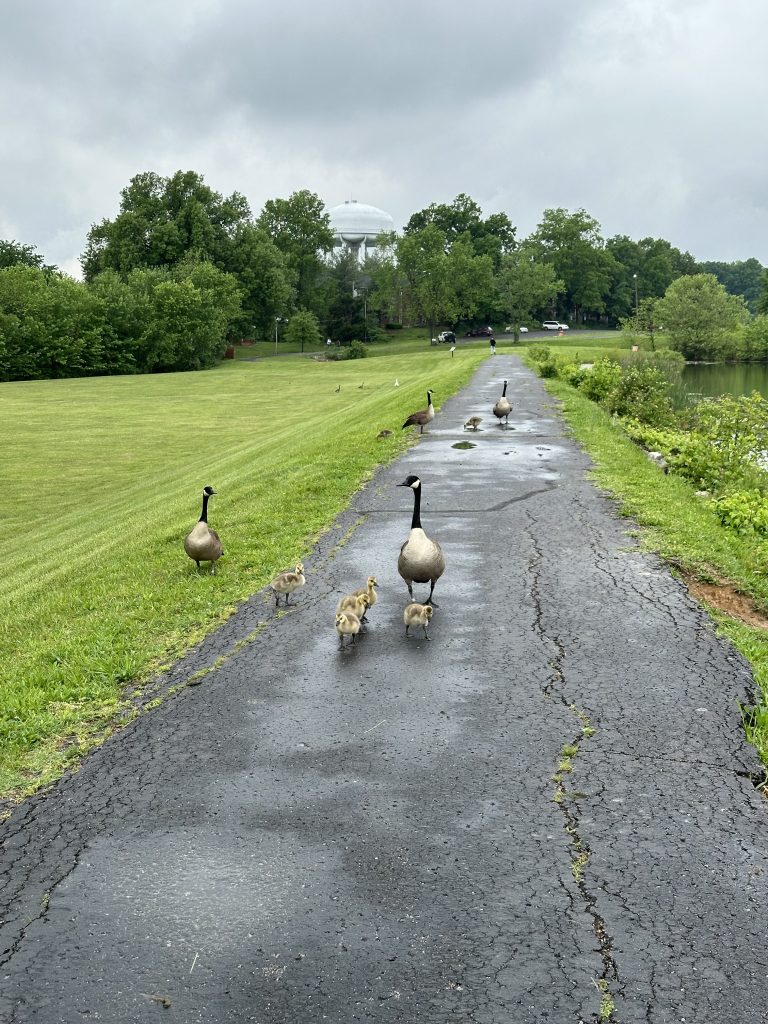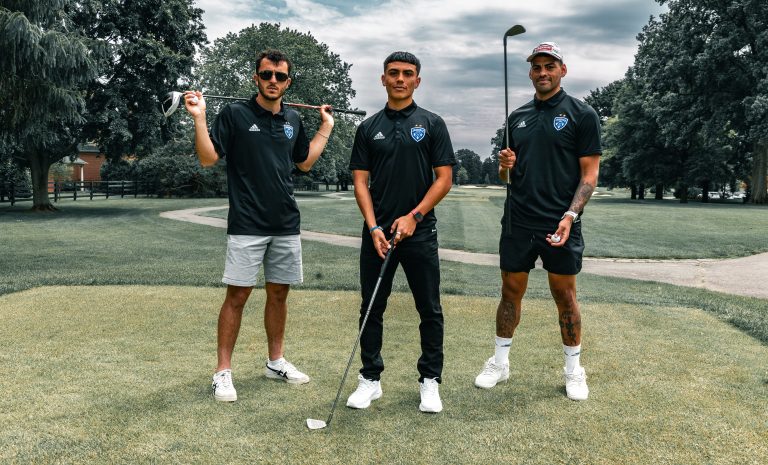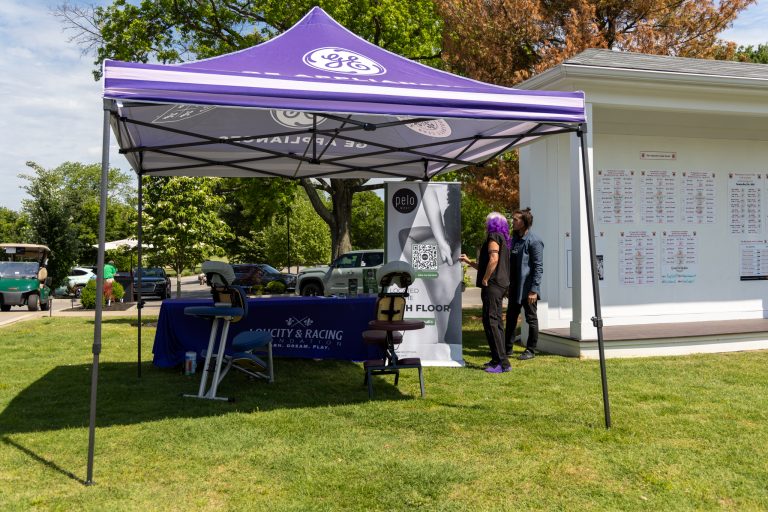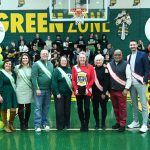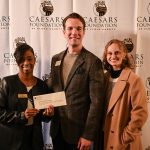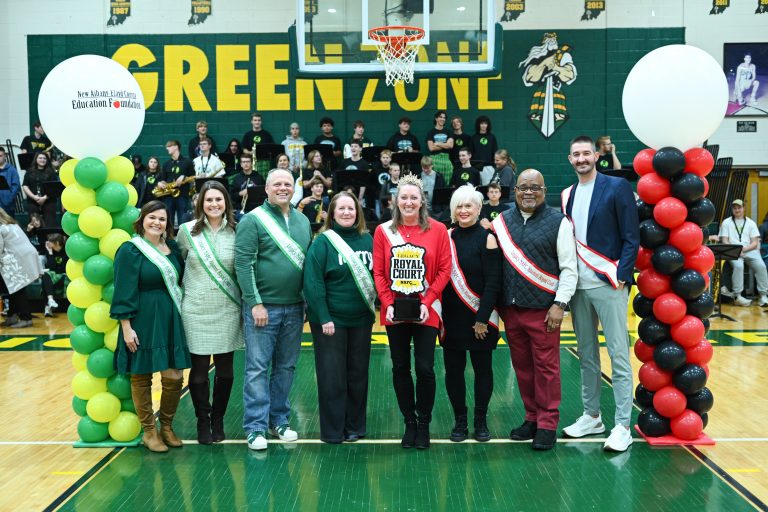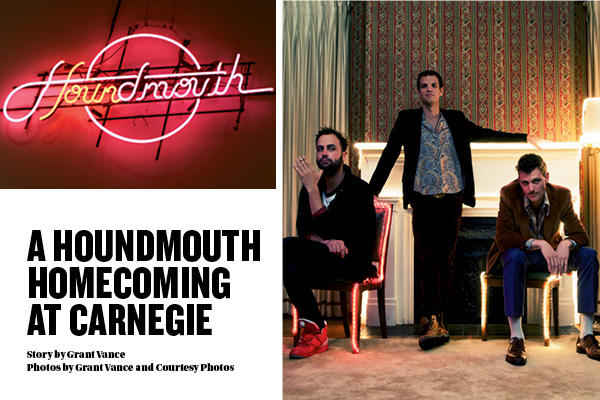
Story by Grant Vance | Photos by Grant Vance and Courtesy Photos

Homecoming is held to especially pertinent standards when it comes to the New Albany-based musicians comprising the rock group Houndmouth. A little bit of southern rock, gospel and folk help describe their style, but Carnegie Center for Art and History knows their sound isn’t simplified by the confines of genre.
“They’re all so grounded in New Albany. When they’re on national TV [Houndmouth doesn’t] say they’re from the Louisville area,” Sally Newkirk, director of the Carnegie Center, said. “They’re like ambassadors for New Albany.”
It’s a naturalistic aspect ingrained in their history, lead guitarist Matt Myers explained. “It wasn’t even something we thought about. It was just, like, this is where we’re from,” he said. “I guess it’s the Midwest in us. We can’t lie even a little bit.”
The Carnegie Center’s Houndmouth exhibit celebrating the band’s “trajectory of success” opened Oct. 28 and runs through Jan. 21. The exhibit is being held in honor of Indiana’s Bicentennial year.
“We were thinking: What can we do that’s different? What can do to attract a younger audience?” Newkirk said, recalling the decision-making process for the exhibit. “So I said, ‘What if we come up with a theme of who’s making history now?’ Houndmouth was perfect.”
Houndmouth is a relatively young band, formed in 2011 and with only two studio albums: From the Hills Below the City (2013) and Little Neon Limelight (2015). They are a four-piece gone three-piece, with Matt Myers on guitar and vocals, Zak Appleby on bass and vocals and Shane Cody on drums and vocals. Katie Toupin, who formerly played keyboard as well as vocals, departed from the band in April of 2016 to “pursue other opportunities,” according to the band’s official statement on their website.
Despite their high profile status, the members of Houndmouth exude high levels of humility.
“(The exhibit is) very flattering,” Myers said.” “We were, like, super hesitant to do it at first.” Newkirk recalled the band’s “deer in the headlights” response when she first approached them about it.
“I was talking to (Shane Cody’s mom) Peggy later of the idea of us doing an exhibit on them because they  really didn’t feel like what they had done warranted an exhibit,” Newkirk said. “I talked to them later and their first reaction (was), ‘Who would even come see it?’ ”
really didn’t feel like what they had done warranted an exhibit,” Newkirk said. “I talked to them later and their first reaction (was), ‘Who would even come see it?’ ”
A busy and vibrant opening night would say otherwise. And to no surprise, considering their growing national recognition.
“Some of my favorite objects are just real unassuming, (like the) cue cards from (being on national TV with) Conan (O’Brien) and (David) Letterman,” Newkirk said. “They’re just pieces of paper that someone has written on. … They’re such unassuming artifacts, but the story they tell is awesome.”
The cue cards are a dynamic addition to the exhibit, but far from the epitome of all it has to offer. Carnegie Center has gone to great links to give an authentic Houndmouth experience, collaborating with everyone from music rights groups such as BMI (Broadcast Music, Inc.) to the band’s families to compile the different attractions, which range from pieces of the band’s clothing to pictures of the members growing up, all of which establish a true intimacy.
“We had to get permission from BMI to make sure we could play Houndmouth music for the three-month run of the show under the license that we currently have from them,” Newkirk said. “But really, we truly couldn’t have done it without the parents and spouses.”
“We left to go on tour and while we were gone, our girlfriends and family went through all our stuff and gave them all our stuff,” Myers said.
The attractions, of course, make the exhibit the intricate experience it is. This is not simply a hall of fame of Houndmouth to date. Rather, it encompasses the group’s artistic sensibilities through artifacts of their history while also offering interactive features, including music hubs granting access to their work, and a Guitar Hero-style game, incorporating a functioning guitar with a specially-developed program allowing users to play through three Houndmouth songs.
The interactive features add some flair, but it’s the intimate attractions grounded in simplicity that really draw home what Houndmouth means to the area. Not to mention their direct ties to the Carnegie Center.
“(Shane Cody’s) grandparents (and two great aunts) were the founders of the museum,” Newkirk explained. “John and B.B. Cody were the New Albany historians. If you had any questions about New Albany history, they were the go-to people.”
Within the exhibit is a room dedicated to some of the art dedicated by the Codys, including George W. Morrison’s New Albany from Silver Hills, which was used as the cover art for Houndmouth’s first LP, From the Hills Below the City.
“I never know how to answer (the question of New Albany’s influence on writing),” Myers said, “but definitely where you grew up affects the music you write. And where you write affects the music you get.”








